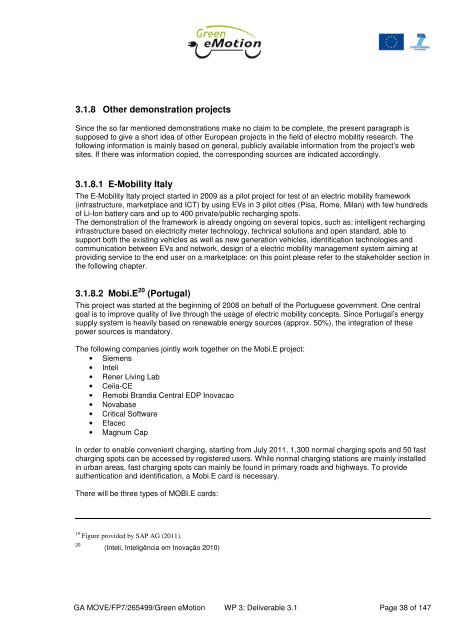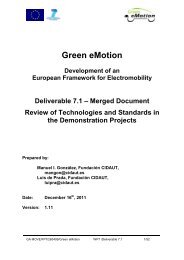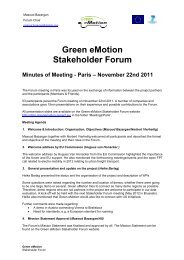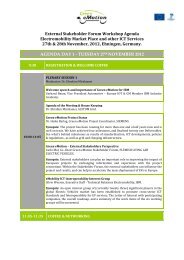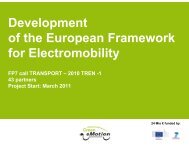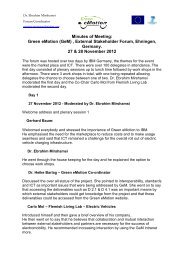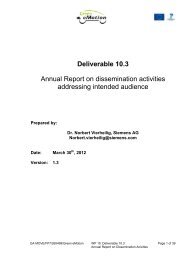Deliverable 3.1 Business Analysis - Green eMotion Project
Deliverable 3.1 Business Analysis - Green eMotion Project
Deliverable 3.1 Business Analysis - Green eMotion Project
Create successful ePaper yourself
Turn your PDF publications into a flip-book with our unique Google optimized e-Paper software.
<strong>3.1</strong>.8 Other demonstration projects<br />
Since the so far mentioned demonstrations make no claim to be complete, the present paragraph is<br />
supposed to give a short idea of other European projects in the field of electro mobility research. The<br />
following information is mainly based on general, publicly available information from the project’s web<br />
sites. If there was information copied, the corresponding sources are indicated accordingly.<br />
<strong>3.1</strong>.8.1 E-Mobility Italy<br />
The E-Mobility Italy project started in 2009 as a pilot project for test of an electric mobility framework<br />
(infrastructure, marketplace and ICT) by using EVs in 3 pilot cities (Pisa, Rome, Milan) with few hundreds<br />
of Li-Ion battery cars and up to 400 private/public recharging spots.<br />
The demonstration of the framework is already ongoing on several topics, such as: intelligent recharging<br />
infrastructure based on electricity meter technology, technical solutions and open standard, able to<br />
support both the existing vehicles as well as new generation vehicles, identification technologies and<br />
communication between EVs and network, design of a electric mobility management system aiming at<br />
providing service to the end user on a marketplace: on this point please refer to the stakeholder section in<br />
the following chapter.<br />
<strong>3.1</strong>.8.2 Mobi.E 20 (Portugal)<br />
This project was started at the beginning of 2008 on behalf of the Portuguese government. One central<br />
goal is to improve quality of live through the usage of electric mobility concepts. Since Portugal’s energy<br />
supply system is heavily based on renewable energy sources (approx. 50%), the integration of these<br />
power sources is mandatory.<br />
The following companies jointly work together on the Mobi.E project:<br />
• Siemens<br />
• Inteli<br />
• Rener Living Lab<br />
• Ceiia-CE<br />
• Remobi Brandia Central EDP Inovacao<br />
• Novabase<br />
• Critical Software<br />
• Efacec<br />
• Magnum Cap<br />
In order to enable convenient charging, starting from July 2011, 1,300 normal charging spots and 50 fast<br />
charging spots can be accessed by registered users. While normal charging stations are mainly installed<br />
in urban areas, fast charging spots can mainly be found in primary roads and highways. To provide<br />
authentication and identification, a Mobi.E card is necessary.<br />
There will be three types of MOBI.E cards:<br />
19 Figure provided by SAP AG (2011).<br />
20<br />
(Inteli, Inteligência em Inovação 2010)<br />
GA MOVE/FP7/265499/<strong>Green</strong> <strong>eMotion</strong> WP 3: <strong>Deliverable</strong> <strong>3.1</strong> Page 38 of 147


